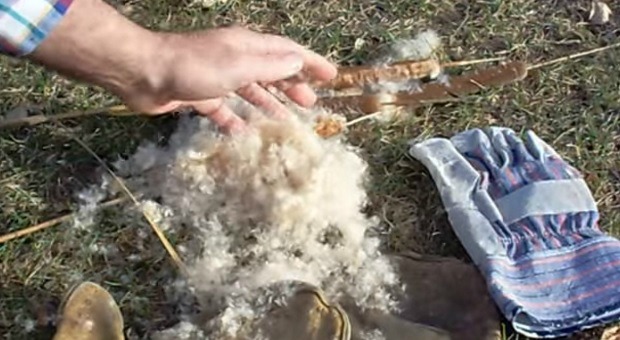Cattail can be best described as the swamp supermarket of preppers, and I am being very serious about my statement. Actually, the legend says that the US was on the verge of winning War World 2 with a little help from the humble cattail.
And if you’re wondering what on God’s green’s earth I am talking about, let me give you one flabbergasting fact: cattail produces more edible starch than almost any green plant (starch per acre that is). From this point of view, cattail is more nutritious than rice, potatoes, yams, or taros.
And speaking of War World 2, the US gummint’ was on the verge of feeding GI Joes with starch originated from the cattail plant right before the war ended.
The only plant that’s capable of beating cattails in terms of carbs (starch is the essential carbohydrate) per acre is lichen, but that’s not a green plant. However, an acre of cattails will produce, on average, 6.5K pounds of flour annually.
Are you starting to get the picture? Cattails, food, survival, the end.
Well, that’s just one small step in our journey aimed at discovering the survival uses of cattail. Truth be told, there’s so much to know about this miraculous plant that I could write a book.
Survival Uses for Cattails
To begin with, there are 2 species of cattail to be found in North America: Typhalatifolia and Typhaangustifolia. However, the cattail got its name from its mature brown cylindrical flower spike.
The dried spikes make for excellent torches while the end-of-season fluffy cattails are the ideal tinder. American Indian folk used cattails for building mattresses, for insulation, and for absorption.
Cattails are so great from a prepper’s point of view that if you’re lost out there in the wild and you managed to get some “tail”, you’ve basically covered four out of five essential survival items: food, water, shelter and fuel for making a fire (the dried stalks are a great source of heating fuel).
It’s important to point out that cattails grow near the water, and regardless where the water flows, you’ll find civilization downstream everywhere in the world.
There’s an old survivalist motto that goes something like this: You name your problem and we’ll improvise a solution from cattails.
As I already told you in the preamble, cattails are very close to a prepper’s seven eleven, the store that never closes out there in the wild.
The fresh (they look like cob) tips of cattail are edible and the same story goes for the white bottom of the stalk, the rootlets off the main roots (they look like spaghetti) and the spurs off the roots. These parts are also rich in vitamin A, B and C, together with essential minerals like phosphorus and magnesium.
The pollen from cattails was used as flour for thousands of years. Eastern Indians were known for their heavy use of cattails, not only for their nutritional value (which is great), but for stuffing and hemp. The fluff was very useful for menstruation and for making diapers.
Discover the survival things the Pioneers took with them when they traveled for months!
Survival Food
Cattails are excellent for their starch content. Here’s a video depicting how to get the starch out of a cattail root. And if you’re wondering why, well, once you got the starch out, it would make for the essential ingredient in your survival kitchen, just like any other flour.
https://www.youtube.com/watch?v=F56i43oN3yY
Video first seen on The Apocalyptic Cookbook.
However, remember not to eat the fiber, you’ll end up with stomach ache.
Here’s a video about how to cook and eat cattails.
Video first seen on David’s Passage.
You can even make pickled cattails! Here is how.
Video first seen on The Northwest Forager.
So, with the food part taken care of, let’s move on to other uses for cattails, shall we?
Let’s enumerate some other survival uses right now: cattail can be used for making pillows, tinder, torches , fire, insulation, for fire transportation. arrow shafts, hand drills, hats, mats, cordage, baskets, bedding, shelters, syrup, bandages for wounds, burns, stings, cuts, bruises, and for mitigating toothaches.
Pretty amazing stuff, isn’t it?
Fire Starting
Now, let’s see about the cigar-shaped cattail seed head, which contains myriads of seeds. When ripe, you can use these seeds as tinder, as they’re dried and highly combustible.
https://www.youtube.com/watch?v=lk-xrVpeBdQ
Video first seen on usframe.
I bet you did not know that if you soak it up right in fat or animal oil, a cattail will burn for up to 6 hours (this is fire transportation by any metric).
https://www.youtube.com/watch?v=2E3HAPrQbIs
Video first seen on bushcraftbartons.
Here is how to start a fire with cattail using hand drill fire.
Video first seen on gundog5.
Insulation
The same seed hairs are incredibly fluffy and soft and if the force is strong in you i.e. if you can gather enough seeds, you can stuff them in pillows. Obviously, if you’re incredibly industrious, you may end up with a mattress made out of cattail seed hairs.
The fluffy cattail seeds make for excellent insulation which can be used to line the inside of clothing or your DIY shoes (think moccasins).
Early civilizations used the seeds for diapers, headgear, bedding, and cushions for cradleboards.
Here’s a tutorial about how to insulate mittens using cattails.
Video first seen on Gregory Logajan.
Making Arrow Shafts
Considering their length and the fact that they’re pretty straight, the cattail stalks are excellent for making arrow shafts. Seeing is believing, so check out this tutorial.
Video first seen on baref00tbushcraft.
All you have to do is to remove excess leaves and allow the stalks to dry out thoroughly in the sun. When they turn brown, that means they’re sturdy enough and they can be transformed into a veritable plethora of arrows.
Making Survival Rope
The leaves can be used for making cordage, due to their broadness/thickness; i.e. you’ll never run out of survival rope (and arrows because cattails are abundant). Check out how to make cattail cordage by clicking here.
Video first seen on Bushland Living.
Making Baskets
Obviously, you can also use cattail leaves for making baskets if you’re skilled and patient enough. Check out the tutorial.
Video first seen on jodajean1.
Making Shelter
You can build yourself a shelter from cattails – a teepee-like structure built from freshly uprooted plants. Here’s the video, check it out.
Video first seen on Shawn Woods.
And you can even heat it with hot stones!
Video first seen on Shawn Woods.
Medicinal Uses
When it comes to medicinal uses, you’ll have to burn cattails and treat abrasions and wounds with the ashes, which have antiseptic properties. The lower part of the stems is rich in amber, a honey-like syrup which is great for treating toothaches and small wounds.
Insect bites, burns and scratches can be mitigated with a poultice made from the mashed core of the root, while cattail’s young flowers treat diarrhea when eaten.
That concludes today’s epic journey into cattail universe. But there are many other survival secrets that helped our forefathers survive during harsh times.
Click the banner below to uncover them!
This article has been written by Chris Black for Survivopedia.






































































Lots of good information, but videos do no good out in the field in a survival situation or after an EMP event.
I print hard copies of things I wish to have on hand in my files to refer to or carry. Hard copies don’t need a battery or wall plug.
I agree with Bob L.: I need step by step, not videos.
is this a real book or an electronic book.
Dale, thank you for asking. The book you see advertised in this article, is a physical product, too.
You have some very interesting stuff here. And I enjoyed watching and listening to it. However, when you were talking about frozen cattails, there is no such word as UNTHAW. To unthaw is to freeze. Think about it.
When we were kids, we would burn Cattails as a mosquito repellent. They are best before the ‘pop’ out into seeds… firm and dark brown in color.
Very interesting, Chris. I always knew that cattails could be eaten, but I didn’t know that there are more uses for it. I would love to try out the starch from it, I think this would be great and very nutritional.